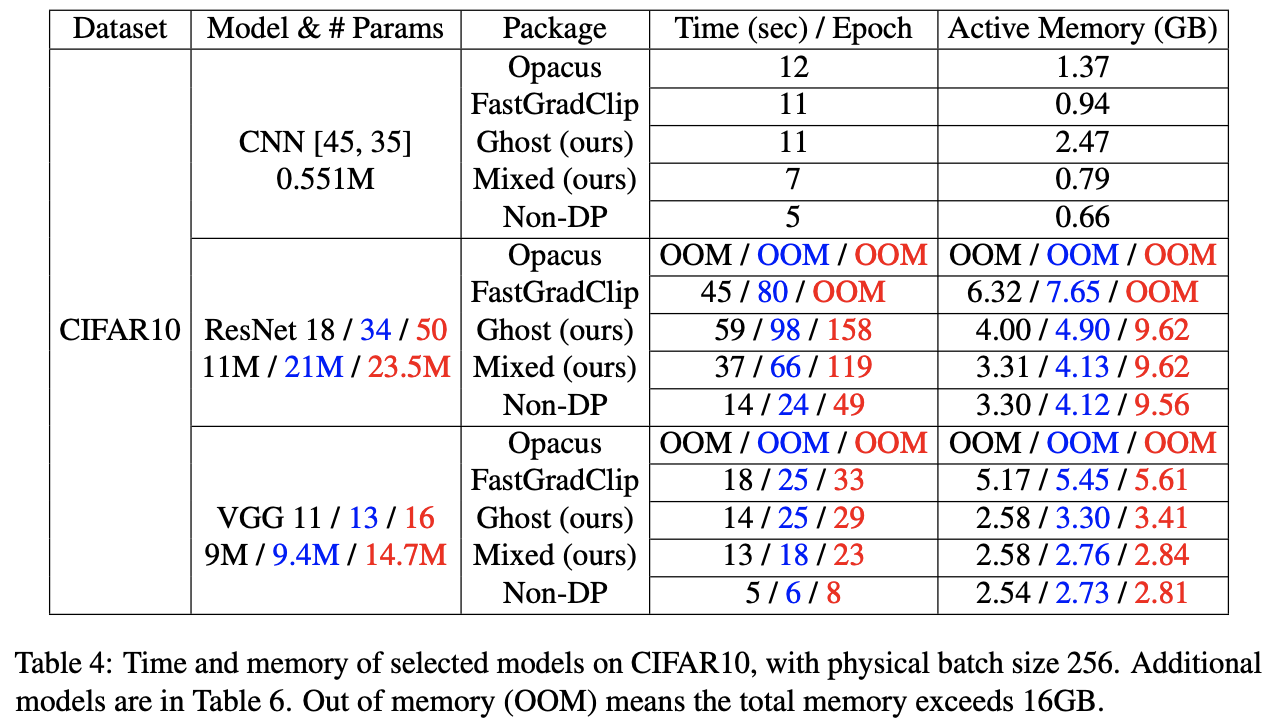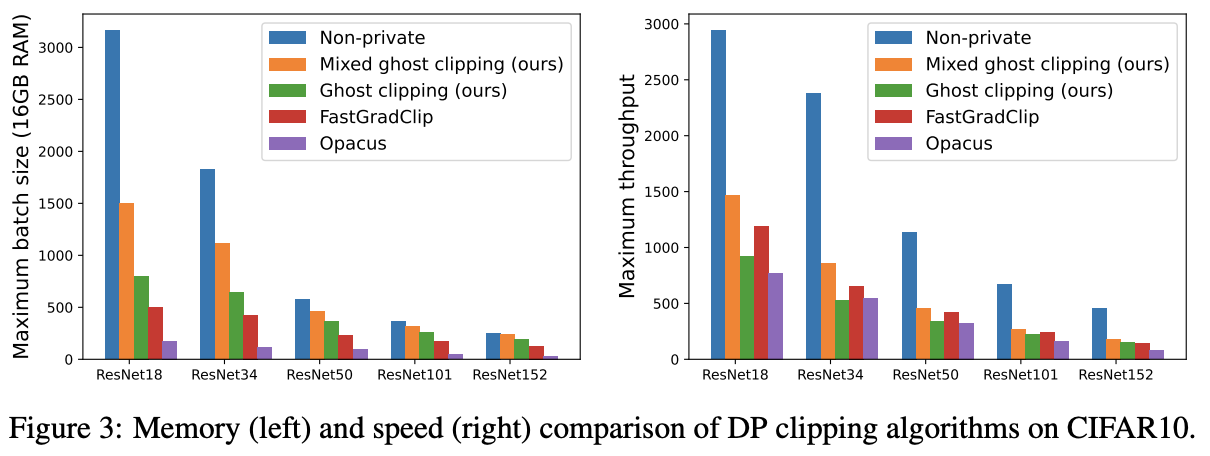This Pytorch codebase implements efficient training of differentially private (DP) convolutional neural networks (CNN), using mixed ghost per-sample gradient clipping.
There are a few DP libraries that change the regular non-private training of neural networks to a private one. Examples include Opacus, FastGradClip, private-transformers, and tensorflow-privacy.
However, they are not suitable for DP training of large CNNs, because they are either not generalizable or computationally inefficient. E.g. causing >20 times memory burden or >5 times slowdown than the regular training.
This codebase implements a new technique --the mixed ghost clipping-- for the convolutional layers, that substantially reduces the space and time complexity of DP deep learning.
- We implement a mixed ghost clipping technique for the Conv1d/Conv2d/Conv3d layers, that trains DP CNNs almost as light as (with 0.1%-10% memory overhead) the regular training. This allows us to train 18 times larger batch size on VGG19 and CIFAR10 than Opacus.
- Larger batch size can improve the throughput of mixed ghost clipping to be 3 times faster than existing DP training methods. On all models we tested, the slowdown is at most 2 times to the regular training.
- We support general optimizers and clipping functions. Loading vision models from codebases such as timm and torchvision, our method can privately train VGG, ResNet, Wide ResNet, ResNeXt, etc. with a few additional lines of code.
- We demonstrate DP training of convolutional Vision Transformers (up to 300 million parameters, again 10% memory overhead and less than 200% slowdonw than non-private training) and improve from 67.4% accuracy in previous SOTA to 83.0% at eps=1.
Privately training vision models is simple:
- Create the model and any optimizer
- Attach this optimizer to our
PrivacyEngine(this essentially adds Pytorch hooks for per-sample clipping) - Compute per-example losses (setting
reduction=='none') for a mini-batch of data - Pass the loss to
optimizer.steporoptimizer.virtual_stepwithout calling thebackward' function (this is implicitly called in thePrivacyEngine`)
Below is a quick example of using our codebase for training CNN models with mixed ghost clipping:
import torchvision, torch, opacus
from private_CNN import PrivacyEngine
model = torchvision.models.resnet18()
# replace BatchNorm by GroupNorm or LayerNorm
model=opacus.validators.ModuleValidator.fix(model)
optimizer = torch.optim.Adam(params=model.parameters(), lr=1e-4)
privacy_engine = PrivacyEngine(
model,
batch_size=256,
sample_size=50000,
epochs=3,
max_grad_norm=0.1,
target_epsilon=3,
ghost_clipping=True,
mixed=True,
)
privacy_engine.attach(optimizer)
# Same training procedure, e.g. data loading, forward pass, logits...
loss = F.cross_entropy(logits, labels, reduction="none")
# do not use loss.backward()
optimizer.step(loss=loss)In the above PrivacyEngine, setting keywords ghost_clipping=True, mixed=False implements the ghost clipping; setting ghost_clipping=True, mixed=True implements the best method, mixed ghost clipping; setting ghost_clipping=False implements similar approach to Opacus, which needs to instantiate the per-sample gradients.
A special use of our privacy engine is to use the gradient accumulation. This is achieved with virtual step function.
import torchvision, torch, timm
from private_CNN import PrivacyEngine
gradient_accumulation_steps = 10
# Batch size/physical batch size. Take an update once this many iterations
model = torchvision.models.resnet18()
model=opacus.validators.ModuleValidator.fix(model)
optimizer = torch.optim.Adam(model.parameters())
privacy_engine = PrivacyEngine(...)
privacy_engine.attach(optimizer)
for i, batch in enumerate(dataloader):
loss = F.cross_entropy(model(batch), labels, reduction="none")
if i % gradient_accumulation_steps == 0:
optimizer.step(loss=loss)
optimizer.zero_grad()
else:
optimizer.virtual_step(loss=loss)- nn.Linear (Ian Goodfellow)
- nn.Linear sequential (Xuechen et al.)
- nn.LayerNorm (Xuechen et al.)
- nn.Embedding (Xuechen et al.)
- Conv1d (this work)
- Conv2d (this work)
- Conv3d (this work)
- nn.GroupNorm (this work)
- Batch normalization does not satisfy DP. This is because the mean and variance of batch normalization is computed from data without privatization. To train DP networks, replace batch normalization with group/instance/layer normalization. Opacus (>v1.0) provides an easy fixer for this replacement via
opacus.validators.ModuleValidator.fix, but you can also change the normalization layer manually. - Extra care needed for sampling. Taking virtual step with fixed virtual batch size is not compatible with Poisson sampling. [Opacus] provides
BatchMemoryManagerto feature this sampling issue and our mixed ghost clipping can be merged easily. Also we didn't use secure PRNG to sample the noise for this experimental codebase.
Please cite our paper if you use private_CNN in your papers, as follows:
@article{bu2022scalable,
title={Scalable and Efficient Training of Large Convolutional Neural Networks with Differential Privacy},
author={Bu, Zhiqi and Mao, Jialin and Xu, Shiyun},
journal={arXiv preprint arXiv:2205.10683},
year={2022}
}
This code is largely based on https://github.com/lxuechen/private-transformers and https://github.com/pytorch/opacus (v0.15).

